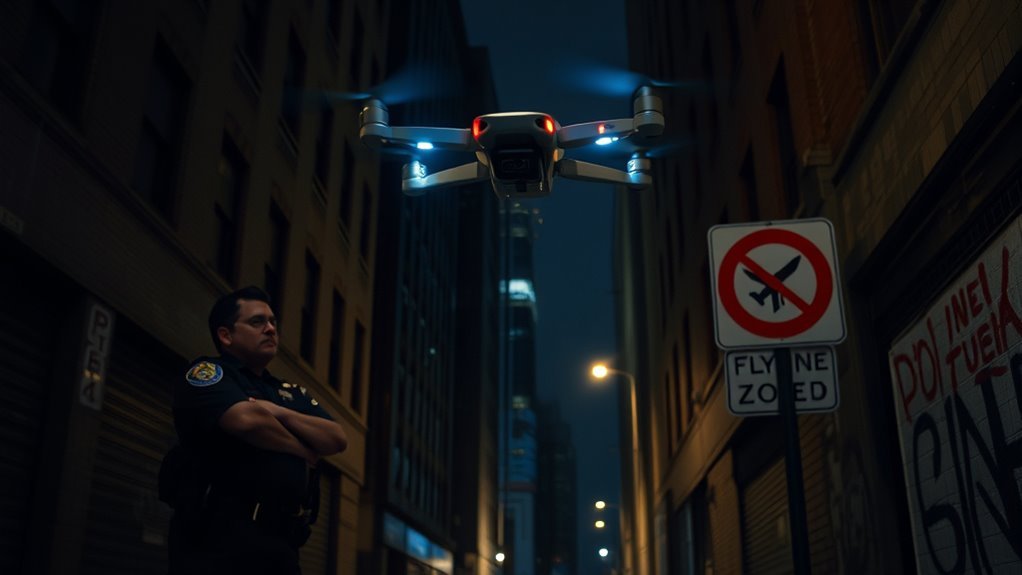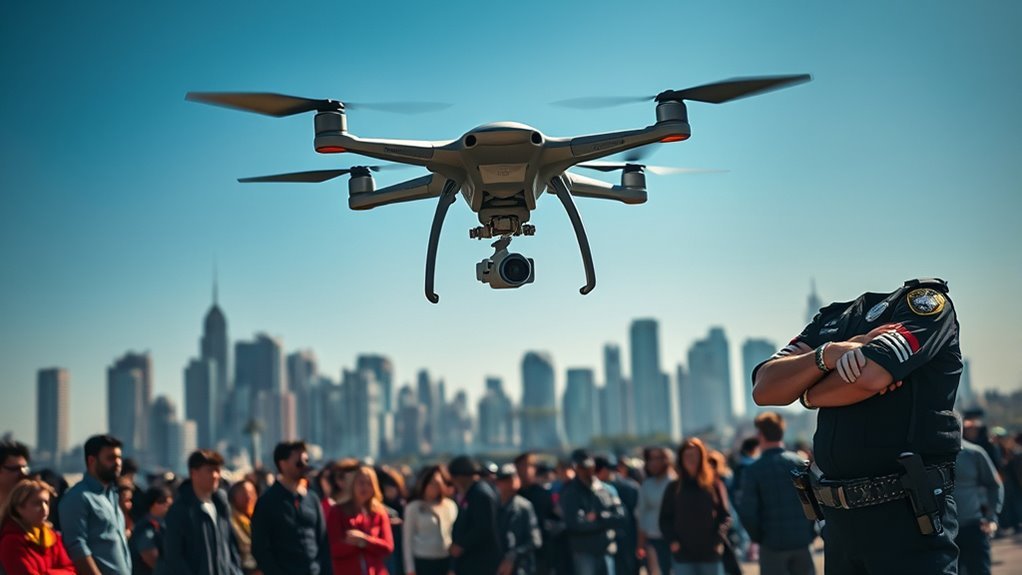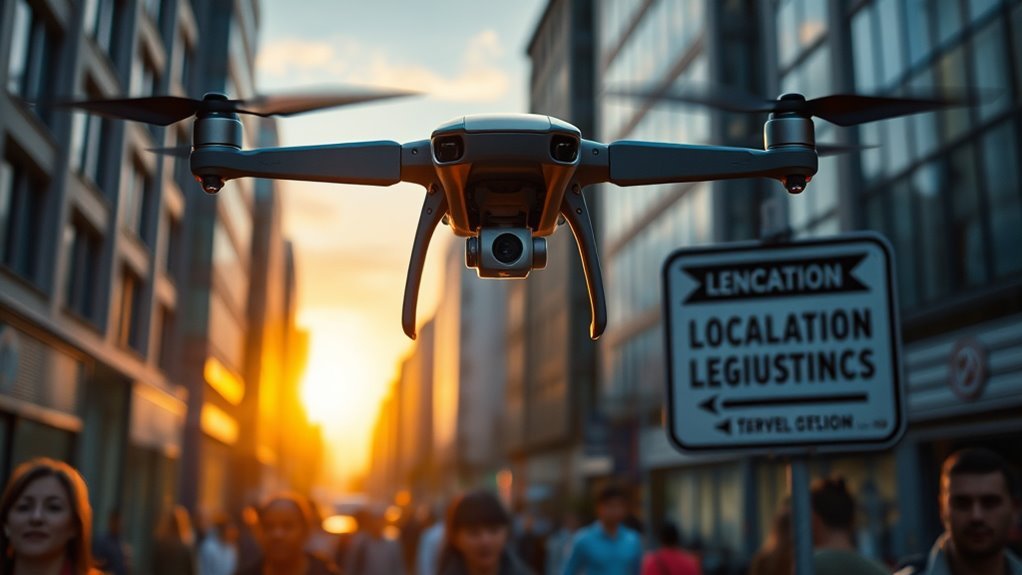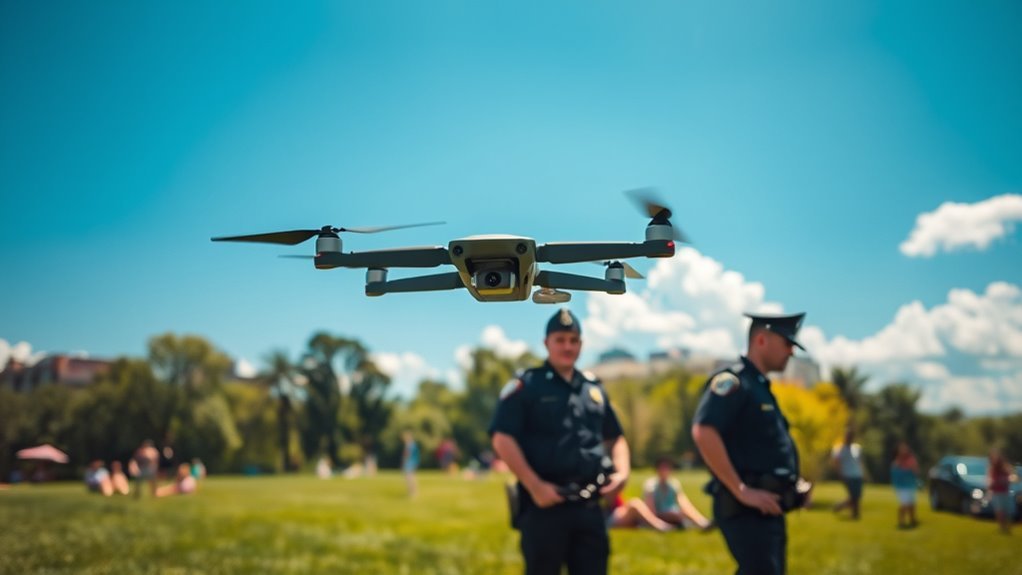The legal limits on police use of drones involve a mix of federal regulations and state laws, emphasizing privacy rights and the need for probable cause. Surveillance typically requires warrants, and data retention policies restrict how long collected information can be stored. Transparency is also essential, with mandates for law enforcement to disclose their drone usage policies. These regulations aim to balance effective policing with individual freedoms, and there’s more to explore regarding their implications.
Overview of Drone Technology in Law Enforcement

As technology continues to evolve, drones have emerged as an essential tool in law enforcement, offering enhanced surveillance and operational capabilities. With their ability to cover vast areas quickly and gather real-time data, drones can markedly improve situational awareness during critical incidents. However, while these drone capabilities present opportunities for increased efficiency, they also bring operational challenges. Law enforcement agencies must navigate issues such as data privacy, public perception, and the integration of drone technology with existing systems. Additionally, maintaining trained personnel to operate these units effectively is imperative. Balancing the benefits of drone usage with the need for accountability and transparency remains a crucial consideration for law enforcement, especially as communities prioritize their rights and freedoms. Furthermore, the integration of advanced AI enhances operational efficiency and decision-making processes in drone usage. Incorporating NDAA-compliant integration ensures that drones operate securely, minimizing risks associated with foreign influences.
Federal Regulations Governing Police Drones

When considering federal regulations governing police drones, it’s essential to examine privacy considerations and flight restrictions. These regulations aim to balance law enforcement capabilities with citizens’ rights. Understanding these frameworks will help clarify how drones can be used effectively while respecting individual privacy.
Privacy Considerations
Although the use of drones by police can enhance surveillance capabilities, it raises significant privacy concerns that are increasingly addressed by federal regulations. These regulations focus on limiting data collection to protect individual freedoms while balancing law enforcement needs.
| Aspect | Consideration | Regulation |
|---|---|---|
| Surveillance Implications | Potential for unwarranted monitoring | Requires probable cause for use |
| Data Collection | Retention policies for collected data | Limits on storage duration |
| Public Transparency | Disclosure of drone usage policies | Mandates public reporting |
| Accountability | Oversight mechanisms for misuse | Establishes review boards |
Understanding these considerations is essential for ensuring that the deployment of police drones respects your privacy rights while maintaining public safety.
Flight Restrictions
While the integration of drones into police operations offers numerous benefits, it is governed by strict federal regulations that impose flight restrictions to guarantee safety and compliance. These regulations delineate specific flight zones where drones can operate, ensuring they don’t interfere with manned aircraft or violate airspace laws. Additionally, altitude restrictions limit how high drones can fly, typically capping operations at 400 feet above ground level in most situations. This framework is designed to protect both the public and law enforcement personnel by minimizing risks associated with drone flights. Understanding these regulations is essential for police departments to navigate the balance between effective surveillance and respecting the freedoms of the community they serve.
State-Level Legislation on Drone Use

State-level legislation on drone use varies greatly across the country, impacting how police can deploy these technologies. You’ll find that many states have enacted specific laws focused on privacy protections, aiming to balance law enforcement needs with citizens’ rights. Understanding these regulations is essential for evaluating the broader implications of drone usage in policing.
State Laws Overview
As of now, more than 30 states have enacted specific laws regulating police use of drones, reflecting a growing recognition of the need for oversight in this area. These state drone laws often outline requirements for transparency, such as obtaining warrants before surveillance. However, enforcement challenges remain significant. Variations in state regulations can lead to confusion and inconsistencies, complicating compliance for law enforcement agencies. Furthermore, the rapid evolution of drone technology outpaces legislative updates, creating potential gaps in regulation. It’s essential for citizens to remain informed about their state’s drone laws, ensuring that police practices align with broader societal values of freedom and privacy. This awareness can help foster a balanced approach to drone use in law enforcement.
Privacy Protections Enacted
With increasing concerns about privacy, many states have implemented legislation aimed at protecting citizens from potential abuses associated with police drone surveillance. These laws often require law enforcement agencies to obtain a warrant before deploying drones for surveillance, ensuring that your privacy rights are upheld. Some states have also mandated transparency, requiring police departments to report drone usage and its purposes, which can help you stay informed about how surveillance technology is used in your community. Additionally, certain regulations address data retention policies, limiting how long surveillance footage can be stored. By enacting these privacy protections, states are acknowledging the privacy implications of drone surveillance and working to balance public safety with individual rights, ultimately fostering a more accountable approach to law enforcement.
Court Rulings Impacting Drone Surveillance
Although courts have recognized the potential benefits of drone surveillance for law enforcement, they’ve also imposed significant legal limitations to protect citizens’ privacy rights. Key court decisions have shaped these surveillance limitations, reinforcing the need for probable cause and warrants in many instances. For example, rulings highlight that using drones for extended surveillance without a warrant breaches Fourth Amendment protections. Additionally, courts have scrutinized law enforcement’s use of drones in public spaces, emphasizing that surveillance must not infringe upon reasonable expectations of privacy. As these court rulings evolve, they play a vital role in balancing effective policing and safeguarding individual freedoms, ensuring that law enforcement practices remain accountable and transparent to the public they serve.
Privacy Rights and Drone Surveillance
While law enforcement agencies increasingly adopt drone technology for surveillance, significant privacy concerns arise regarding citizens’ rights. You’ve got a right to expect drone transparency in how these tools are used. When police deploy drones, the potential for invasive surveillance raises questions about accountability. Are they monitoring you without cause? Without clear regulations, it’s easy for misuse to occur. You deserve to know when and why drones are surveilling your neighborhood. This lack of clarity could erode public trust in law enforcement. To protect your privacy, it’s essential that laws evolve, ensuring surveillance accountability. Striking a balance between public safety and individual rights is vital in shaping a future where technology respects personal freedoms while serving the community’s needs. Additionally, regulations governing drone safety and airspace management are crucial to prevent unauthorized surveillance and maintain public trust.
Ethical Considerations in Police Drone Deployments
As police departments increasingly integrate drones into their operations, ethical considerations surrounding their deployment become paramount. You should recognize the ethical implications of using drones for surveillance and law enforcement. These technologies raise concerns about civil liberties, including privacy and autonomy. Drones can facilitate intrusive monitoring, which poses risks to public accountability. When deploying drones, police must guarantee transparency in their operations and the data collected. Establishing clear guidelines and oversight mechanisms can help mitigate ethical dilemmas, fostering trust between law enforcement and the community. Ultimately, balancing effective policing with respect for individual freedoms is essential. By addressing these ethical considerations, you can support a framework that prioritizes both security and the rights of citizens.
Public Perception and Acceptance of Police Drones
How do communities truly feel about the use of drones by law enforcement? Public opinion varies widely, reflecting a mix of support and substantial skepticism. Many individuals express community concerns about privacy violations, fearing constant surveillance may infringe on personal freedoms. On the other hand, some believe drones can enhance safety and efficiency in policing, especially in emergency situations. However, the acceptance of police drones often hinges on transparency and accountability measures. When communities feel informed about how drones are used and protected from misuse, they may be more receptive. Ultimately, fostering trust between law enforcement and the public is vital, as this relationship shapes the overall perception and acceptance of drone technology in policing.
Case Studies of Drone Usage by Law Enforcement
Case studies of drone usage by law enforcement reveal a complex landscape shaped by varied applications and outcomes. In recent drone incidents, some departments have deployed drones for surveillance during protests, igniting debates over privacy and civil liberties. Conversely, other cases demonstrate effective use in search and rescue operations, showcasing drones’ potential benefits. Legal precedents are still evolving; courts have grappled with balancing public safety against individual rights. For instance, rulings have emerged surrounding warrant requirements for drone surveillance, emphasizing the need for clear guidelines. As law enforcement agencies navigate these complexities, understanding past incidents can inform future policies, ensuring that the use of drones respects freedoms while addressing community safety concerns.
Future Trends in Police Drone Regulations
While the use of drones by law enforcement has expanded rapidly, future trends in police drone regulations are likely to focus on enhancing accountability and transparency. As emerging technologies continue to evolve, you’ll see increased scrutiny surrounding their deployment. Regulatory challenges will need to be addressed, ensuring that civil liberties are respected while maintaining public safety.
| Focus Area | Future Trends |
|---|---|
| Accountability | Mandatory oversight mechanisms |
| Transparency | Public access to drone data |
| Privacy Protections | Enhanced guidelines on data use |
These changes aim to strike a balance between effective policing and the preservation of individual freedoms, ensuring drones serve the community without overstepping boundaries.
Frequently Asked Questions
Can Police Drones Be Armed for Use in Law Enforcement?
You might wonder if police can use armed drones in law enforcement. The legal implications are complex, often prohibiting weaponization due to concerns over civil liberties, accountability, and the potential for abuse in policing practices.
What Types of Drones Are Commonly Used by Police?
You’ll find that police commonly use drones equipped with advanced drone technology for aerial surveillance purposes. These unmanned aerial vehicles enhance situational awareness, assist in crowd monitoring, and support search-and-rescue operations while ensuring public safety.
How Are Police Drones Funded and Maintained?
Police drones are funded through government budgets, grants, or community initiatives. Maintenance costs include repairs, software updates, and training for personnel, ensuring operational efficiency while balancing public concerns about privacy and resource allocation.
What Training Do Officers Receive for Operating Drones?
Officers typically undergo drone certification training, focusing on operational guidelines. This guarantees they’re equipped to use drones effectively and responsibly, balancing technological capabilities with the community’s rights and privacy, fostering a sense of freedom.
Can Citizens Challenge Police Drone Usage in Court?
Challenging police drone usage in court’s like maneuvering through a maze. You can contest it under drone regulations and legal precedents, but success often hinges on demonstrating violations of privacy or rights, which can be complex.

